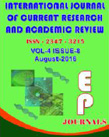Abstract Volume:4 Issue-8 Year-2016 Original Research Articles
 |
Online ISSN : 2347 - 3215 Issues : 12 per year Publisher : Excellent Publishers Email : editorijcret@gmail.com |
Nowadays, spinal anesthesia is the selected anesthesia technique for elective cesarean section and emergency cases because of the low incidence of maternal mortality and morbidity and less infant depression in this method compared to general anesthesia. Unavoidable Hypothermia refers to the reduction of the core temperature below 36°c. Hypothermia and shivering during and after anesthesia has adverse results and complications which lead to dysfunction of monitoring of electrocardiogram, blood pressure and arterial oxygen saturation, in addition to incidence of discomfort and bad feelings in patients. The aim of this study is to evaluate the influence of prophylactic administration of intravenous Ondansetron in controlling shivering during and after spinal anesthesia for caesarean section. In a double-blind clinical trial, 40 patients were randomly divided into two groups of 20 people. After recording vital signs and basal body core temperature of patients undergoing spinal anesthesia, and after birth, the case group received about 8 mg (2 ml) Ondansetron drug and the control group received the same amount of normal saline. The score of shivering, blood pressure, core body temperature, need for medical treatment of shivering and existence of any possible side effect during surgery and recovery were measured and recorded. Demographic findings did not show significant differences except for weight. The mean score of shivering in the operating room was about 0.30±0.57 in patients in the case group and 1.35±1.25 in patients in the control group. The mean score of shivering in the recovery ward was about 1.45±1.09 in patients in the case group and 2.25±1.37 in patients in the control group, which represents a decreased incidence score of shivering in the control group (p =0.02), however patients in both groups showed no significant difference in terms of severity of shivering and thus the need for Pethidine analgesic drug (p = 0.049). Significantly low mean score of shivering in the operating room and in recovery in patients in the case group compared to that in patients in the control group (P<0.001 and P<0.001) represents the effective role of Ondansetron in reduction of the level of shivering in patients, however this drug does not reduce the intensity of shivering.
How to cite this article:
Farnaz Moslemi, Shabnam Ghandiha, Sousan Rasooli, Morteza Gojazadeh. 2016. The Effect of Prophylactic Administration of Intravenous Ondansetron for Control of Shivering during and after Spinal Anesthesia for Cesarean Section.Int.J.Curr.Res.Aca.Rev. 4(8): 198-208doi: http://dx.doi.org/10.20546/ijcrar.2016.408.016



Quick Navigation
- Print Article
- Full Text PDF
- How to Cite this Article
- on Google
- on Google Scholor
- Citation Alert By Google Scholar
